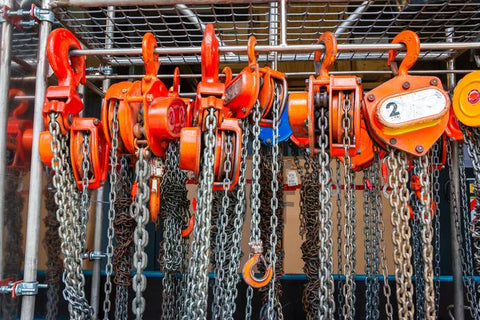Introduction:
In the bustling industrial landscape of the UK, chain blocks are an indispensable tool. These manual hoists, integral to lifting and handling heavy loads, can be found in warehouses, construction sites, and manufacturing facilities across the nation. However, their utility comes with a caveat - safety. In this guide, we delve into the crucial aspects of chain block safety, offering insights and best practices to ensure accident-free operations in your workspace.

Understanding Chain Blocks:
A chain block, or manual chain hoist, is a device used to lift and lower heavy loads using a chain. Simple in design yet powerful in function, it operates through a pulley system, which is controlled manually. Their popularity in the UK stems from their reliability, ease of use, and cost-effectiveness.
Key Safety Features of Chain Blocks:
1. Load Capacity: Always check the maximum load capacity, which should be clearly marked on the chain block. Overloading is a primary cause of accidents.
2. Regular Inspections: Implement a routine for inspecting the chain, hooks, and locking mechanisms for wear and tear.
3. Quality Standards: Ensure your chain block adheres to UK safety standards, such as BS EN 13157, which specify requirements for the design and construction of the equipment.
Safe Operating Practices:
- Training: Operators should be adequately trained in using chain blocks, including understanding load limits and the importance of smooth operation.
- Load Stability: Ensure the load is properly balanced and secured before lifting.
- Environment Check: Regularly assess the environment for potential hazards like obstructions or uneven surfaces.

Maintenance and Care:
Proper maintenance is key to the longevity and safety of a chain block. Regular lubrication of the chain, timely replacement of worn components, and storing the equipment in a dry, clean environment are essential practices.
Emergency Protocols:
Develop and educate your team on emergency response procedures in case of a chain block failure or accident. Quick and efficient action can significantly reduce the risk of injury.
Conclusion:
Chain blocks are a vital component in the UK’s industrial sector, but their benefits are fully realized only when used safely. By adhering to safety guidelines, conducting regular maintenance, and ensuring proper operator training, you can maintain a safe and efficient working environment. Remember, safety in the use of manual hoists isn't just a regulatory requirement; it's a commitment to the well-being of your team.

